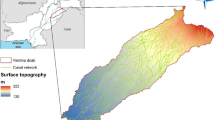Abstract
The holistic approach of Driver-Pressure-State-Impact-Response (DPSIR) methodology was applied to selected Cr(VI) impacted groundwater bodies of Central Greece. The main driving forces in the study areas are agricultural activities, urban and industrial development as well as tourism. The main pressures induced by the anthropogenic activities are fertilizer use, uncontrolled urban sewage disposal and industrial effluents discharges. Groundwater stress is caused by the qualitative degradation due to Cr(VI), NO3−, Cl− and SO42− contamination. Hexavalent chromium occurrence is attributed to both geogenic and anthropogenic sources. The maximum Cr(VI) concentration (11.7 mg/L) was measured in Oinofyta area. Important impacts are the deterioration of groundwater body chemical status as well as the decline of groundwater use efficiency. Based on the applied DPSIR, a management framework is proposed in order to address the complex environmental issue of Cr(VI) in the study areas.





Similar content being viewed by others
References
Apollaro C, Fuoco I, Brozzo G, De Rosa R (2019) Release and fate of Cr (VI) in the ophiolitic aquifers of Italy: the role of Fe (III) as a potential oxidant of Cr (III) sup- ported by reaction path modelling. Sci Total Environ 660:1459–1471
Becquer T, Quantin C, Sicot M, Boudot JP (2003) Chromium availability in ultramafic soils from New Caledonia. Sci Total Environ 301:251–261. https://doi.org/10.1016/S0048-9697(02)00298-X
EEA (1999) Environmental indicators: typology and overview. In: Smeets E, Weterings R (eds) Technical report no 25, p 19
Despotidou M (2016), Integrated management of industrial effluents of Assopos area, phD thesis, National Technical University of Athens
Dermatas D, Panagiotakis I, Mpouras T, Tettas K (2017) The origin of hexavalent chromium as a critical parameter for remediation of contaminated aquifers. Bull Environ Contamin Toxicol 98(3):331–337
Gari SR, Ortiz Guerrero CE, Uribe B, Icely JD, Newton A (2018) A DPSIR-analysis of water uses and related water quality issues in the Colombian Alto and Medio Dagua Community Council. Water Sci. 32(2):318–337
Giannoulopoulos, P.A., (2008). Preliminary hydrological- hydrochemical research. Contamination of Ground Water in the Assopos Basin, Boeotia Region. Internal Report. IGME, Athens, p 74 (in Greek)
Gueye MT, Di Palma L, Allahverdiyeva G, Bavasso I, Petrucci E, Stoller M, Vilardi G (2016) The influence of heavy metals and organic matter on hexavalent chromium reduction by nano zero valent iron in soil. Chem Eng Trans 47:289–294
Hausladen DM, Alexander-Ozinskas A, McClain C, Fendorf S (2018) Hexavalent chromium sources and distribution in California groundwater. Environ Sci Technol 52(15):8242–8251
Kaprara E, Kazakis N, Simeonidis K, Coles S, Zouboulis AI, Samaras P, Mitrakas M (2015) Occurrence of Cr (VI) in drinking water of Greece and relation to the geological background. J Hazard Mater 281:2–11
Kounis, D., Vitoriou-Georgouli, A., (2003). Hydrogeological Survey regarding the hydrological balance of the metallic aquifer of Loutraki area. Institute of Geology and Mineral Exploration (IGME), Athens (in Greek)
Mills CT, Goldhaber MB (2012) Laboratory investigations of the effects of nitrification-induced acidification on Cr cycling in vadose zone material partially derived from ultramafic rocks. Sci Total Environ 435:363–437
Papazotos P, Vasileiou E, Perraki M (2019) The synergistic role of agricultural activities in groundwater quality in ultramafic environments: the case of the Psachna basin, central Euboea. Greece Environ Monit Assess 191(5):317
Acknowledgements
This research was co-funded by the European Union (ERDF) and Greek national funds through the Operational Program "Competitiveness, Entrepreneurship and Innovation", under the ERANETMED 1st Joint Call on Water Resources (project acronym: CrITERIA/ project code: T3EPA-00004).
Author information
Authors and Affiliations
Corresponding author
Additional information
Publisher's Note
Springer Nature remains neutral with regard to jurisdictional claims in published maps and institutional affiliations.
Electronic supplementary material
Below is the link to the electronic supplementary material.
Rights and permissions
About this article
Cite this article
Pyrgaki, K., Argyraki, A., Kelepertzis, E. et al. A DPSIR Approach to Selected Cr(VI) Impacted Groundwater Bodies of Central Greece. Bull Environ Contam Toxicol 106, 446–452 (2021). https://doi.org/10.1007/s00128-020-02889-8
Received:
Accepted:
Published:
Issue Date:
DOI: https://doi.org/10.1007/s00128-020-02889-8




